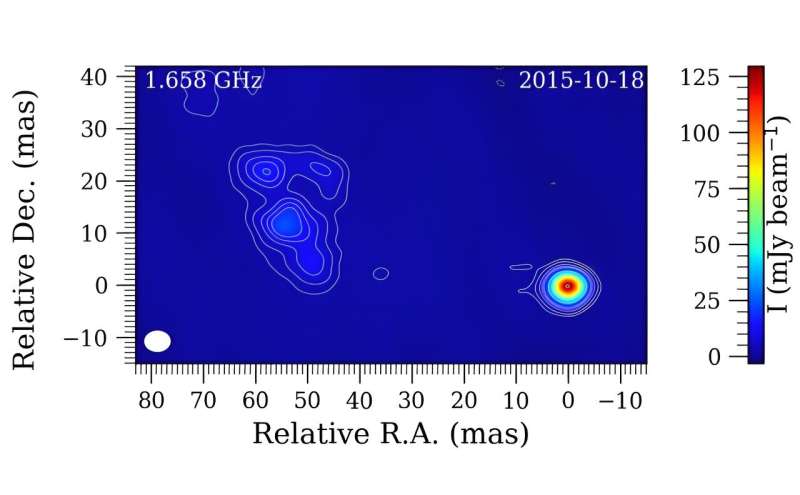February 26, 2024 report
This article has been reviewed according to Science X's editorial process and policies. Editors have highlighted the following attributes while ensuring the content's credibility:
fact-checked
trusted source
proofread
Observations explore radio jet of a powerful quasar

European astronomers have conducted very long baseline interferometric (VLBI) observations of a radio jet structure in a powerful quasar known as PKS 2215+020. The collected VLBI data provide important insights into the properties of this jet, suggesting that PKS 2215+020 is a blazar. The findings were presented February 17 in the Universe journal.
Quasars, or quasi-stellar objects (QSOs) are active galactic nuclei (AGN) of very high luminosity, emitting electromagnetic radiation observable in radio, infrared, visible, ultraviolet and X-ray wavelengths.
They are among the brightest and most distant objects in the known universe, and serve as fundamental tools for numerous studies in astrophysics as well as cosmology. For instance, quasars have been used to investigate the large-scale structure of the universe and the era of reionization. They also improve our understanding of the dynamics of supermassive black holes and the intergalactic medium.
PKS 2215+020 is a powerful flat-spectrum radio quasar at a redshift of 3.572. It has a rest-frame monochromatic power at 5 GHz of some 20 RW/Hz and its supermassive black hole is estimated to be four billion times more massive than the sun.
Previous observations of PKS 2215+020 have found that its morphology is dominated by a bright compact core that continues in a series of weak jet components, ending and also brightening up in the most extended jet component. This remarkably large radio jet structure has a linear size of about 1,950 light years, projected onto the plane of the sky.
A team of astronomers led by Sándor Frey of the Konkoly Observatory in Budapest, Hungary, decided to investigate the jet of PKS 2215+020, aiming to reveal its physical and geometric properties. For this purpose, they employed the Very Long Baseline Array (VLBA) of the U.S. National Radio Astronomy Observatory (NRAO).
"We collected and analyzed archival multi-epoch VLBI imaging data at five different frequency bands (1.7, 2.3, 4.4, 7.4–8.7, and 15.3–15.4 GHz) taken at several epochs between 1995 and 2020, but mostly after 2010. The images with ∼1–10 mas scale angular resolutions show the bright compact core region resolved into distinct emission components at higher frequencies, and an extended, steep-spectrum feature ∼ 56 mas from the core at lower frequencies," the researchers wrote in the paper.
VLBI imaging allowed the team to determine the apparent proper motions of jet components in PKS 2215+020 for the first time. It turned out that the jet showed a moderately superluminal motion with an apparent speed of 2.1 times the speed of light, and its apparent proper motion was approximately 0.02 mas per year.
Based on these data, the Doppler boosting factor in the inner relativistic jet was calculated to be 11.5. The jet was found to be inclined 1.8 degrees to the line of sight and its bulk Lorentz factor was measured to be 6.0.
According to the researchers, the collected data indicate that PKS 2215+020 is a blazar. In general, blazars, classified as members of a larger group of active galaxies that host AGNs, are the most numerous extragalactic gamma-ray sources. Their characteristic features are relativistic jets pointed almost exactly toward the Earth.
The authors of the paper underlined that the small apparent proper motion value and jet parameters obtained for PKS 2215+020 are typical for other known radio AGNs at high redshift (above 3.5).
More information: Sándor Frey et al, Revisiting a Core–Jet Laboratory at High Redshift: Analysis of the Radio Jet in the Quasar PKS 2215+020 at z = 3.572, Universe (2024). DOI: 10.3390/universe10020097
© 2024 Science X Network




















